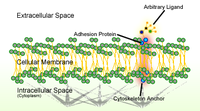
Photo from wikipedia
Desmosomes are adhesive junctions composed of two desmosomal cadherins: desmocollin (Dsc) and desmoglein (Dsg). Previous studies demonstrate that E-cadherin (Ecad), an adhesive protein that interacts in both trans (between opposing… Click to show full abstract
Desmosomes are adhesive junctions composed of two desmosomal cadherins: desmocollin (Dsc) and desmoglein (Dsg). Previous studies demonstrate that E-cadherin (Ecad), an adhesive protein that interacts in both trans (between opposing cells) and cis (on the same cell surface) conformations, facilitates desmosome assembly via an unknown mechanism. Here we use structure-function analysis to resolve the mechanistic roles of Ecad in desmosome formation. Using AFM force measurements, we demonstrate that Ecad interacts with isoform 2 of Dsg via a conserved Leu-175 on the Ecad cis binding interface. Super-resolution imaging reveals that Ecad is enriched in nascent desmosomes, supporting a role for Ecad in early desmosome assembly. Finally, confocal imaging demonstrates that desmosome assembly is initiated at sites of Ecad mediated adhesion, and that Ecad-L175 is required for efficient Dsg2 and desmoplakin recruitment to intercellular contacts. We propose that Ecad trans interactions at nascent cell-cell contacts initiate the recruitment of Dsg through direct cis interactions with Ecad which facilitates desmosome assembly.
Journal Title: eLife
Year Published: 2018
Link to full text (if available)
Share on Social Media: Sign Up to like & get
recommendations!